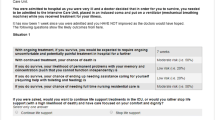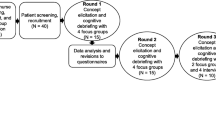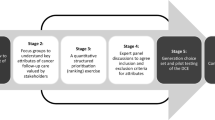Abstract
Background
Studies have demonstrated that patients at low risk for febrile neutropenia (FN) complications can be treated safely and effectively at home. Information on patient preferences for outpatient treatment of this condition will help to optimize health care delivery to these patients. The purpose of this study was to elicit non-Hodgkin lymphoma patients’ preferences on attributes related to outpatient treatment of FN.
Methods
We used a self-administered discrete choice experiment questionnaire based on the attributes of out-of-pocket costs, unpaid caregiver time required daily, and probability of return to the hospital. Ten paired scenarios in which levels of the attributes were varied were presented to study patients. For each pair, patients indicated the scenario they preferred. Adjusted odds ratios (ORs) of accepting a scenario that described outpatient care for FN were estimated.
Results
Eighty-eight patients completed the questionnaire. Adjusted ORs [95 % confidence intervals] of accepting outpatient care for FN were 0.84 [0.75, 0.95] for each $10 increase in out-of-pocket cost; 0.82 [0.68, 0.99] for each 1 h increase in daily unpaid caregiver time; and 0.53 [0.50, 0.57] for each 5 % increase in probability of return to the hospital.
Conclusions
Probability of return to the hospital was the most important attribute to patients when considering home-based care for FN. Patients considered out-of-pocket costs and unpaid caregiver time to be less important than probability of return to the hospital. This study identifies factors that could be incorporated into outpatient delivery systems for FN care to ensure adequate patient uptake and satisfaction with such programs.

Similar content being viewed by others
References
Kuderer NM, Dale DC, Crawford J et al (2006) Mortality, morbidity, and cost associated with febrile neutropenia in adult cancer patients. Cancer 106:2258–2266
Lathia N, Mittmann N, DeAngelis C et al (2010) Evaluation of direct medical costs of hospitalization for febrile neutropenia. Cancer 116:742–748
Cherif H, Johansson E, Bjorkholm M, Kalin M (2006) The feasibility of early hospital discharge with oral antimicrobial therapy in low risk patients with febrile neutropenia following chemotherapy for hematologic malignancies. Haematologica 91:215–222
Innes H, Lim SL, Hall A et al (2008) Management of febrile neutropenia in solid tumours and lymphomas using the Multinational Association for Supportive Care in Cancer (MASCC) risk index: feasibility and safety in routine clinical practice. Support Care Cancer 16:485–491
Innes HE, Smith DB, O'Reilly SM et al (2003) Oral antibiotics with early hospital discharge compared with in-patient intravenous antibiotics for low-risk febrile neutropenia in patients with cancer: a prospective randomised controlled single centre study. Br J Cancer 89:43–49
Klastersky J, Paesmans M, Georgala A et al (2006) Outpatient oral antibiotics for febrile neutropenic cancer patients using a score predictive for complications. J Clin Oncol 24:4129–4134
Mizuno T, Katsumata N, Mukai H et al (2007) The outpatient management of low-risk febrile patients with neutropenia: risk assessment over the telephone. Support Care Cancer 15:287–291
Rolston KV, Manzullo EF, Elting LS et al (2006) Once daily, oral, outpatient quinolone monotherapy for low-risk cancer patients with fever and neutropenia: a pilot study of 40 patients based on validated risk-prediction rules. Cancer 106:2489–2494
Bennett CL, Calhoun EA (2007) Evaluating the total costs of chemotherapy-induced febrile neutropenia: results from a pilot study with community oncology cancer patients. Oncologist 12:478–483
Elting LS, Lu C, Escalante CP et al (2008) Outcomes and cost of outpatient or inpatient management of 712 patients with febrile neutropenia. J Clin Oncol 26:606–611
Hendricks A, Loggers E, Talcott J (2011) Costs of home versus inpatient treatment for fever and neutropenia: analysis of a multicenter randomized trial. J Clin Oncol 29:3984–3989
Ryan M, Farrar S (2000) Using conjoint analysis to elicit preferences for health care. Brit Med J 320:1530–1533
King MT, Hall J, Lancsar E et al (2007) Patient preferences for managing asthma: results from a discrete choice experiment. Health Econ 16:703–717
Phillips KA, Maddala T, Johnson FR (2002) Measuring preferences for health care interventions using conjoint analysis: an application to HIV testing. Health Serv Res 37:1681–1705
Hauber AB, Johnson FR, Sauriol L, Lescrauwaet B (2005) Risking health to avoid injections: preferences of Canadians with type 2 diabetes. Diabetes Care 28:2243–2245
Bryan S, Gold L, Sheldon R, Buxton M (2009) Preference measurement using conjoint methods: an empirical investigation of reliability. Health Econ 9:385–395
Ryan M, Watson V, Amaya-Amaya M (2003) Methodological issues in the monetary valuation of benefits in healthcare. Exp Rev Pharmacoecon Outcomes Res 3:717–727
National Comprehensive Cancer Network (2011) NCCN Clinical Practice Guidelines in Oncology Prevention and Treatment of Cancer-Related Infections V.2.2009. Available at http://www.nccn.org/professionals/physician_gls/pdf/infections.pdf. Accessed 14 April 2011.
Street DJ, Burgess L, Louviere JL (2005) Quick and easy choice sets: constructing optimal and nearly optimal stated choice experiments. Int J Res Mark 22:459–470
Dranitsaris G, Tran TM (1995) Economic analyses of toxicity secondary to anthracycline-based breast cancer chemotherapy. Eur J Cancer 31A:2174–2180
Leese B, Collin R, Clark DJ (1994) The costs of treating febrile neutropenia in patients with malignant blood disorders. PharmacoEconomics 6:233–239
Montero MC, Valdivia ML, Carvajal E et al (1994) Economic study of neutropenia induced by myelotoxic chemotherapy. Pharm World Sci 16:187–192
Stommel M, Given CW, Bam G (1993) The cost of cancer home care to families. Cancer 71:867–1874
Acknowledgments
We thank Dr. Rachael Cayley from the Office of English Language and Writing Support at the University of Toronto for her assistance with copyediting of this manuscript. This work was supported by a Clinical Research Fellowship from the Canadian Institutes of Health Research (CFE-109446) that was awarded to NL and an unrestricted educational grant from Amgen Canada that was awarded to NL and NM.
Conflict of interest
NM and NL received an unrestricted educational grant from Amgen Canada in support of this work. All remaining authors have declared no conflicts of interest. The authors had full control over the conduct of this work and the decision to publish and allow the journal to review data if requested.
Author information
Authors and Affiliations
Corresponding author
Electronic supplementary material
Below is the link to the electronic supplementary material.
ESM 1
(PDF 51 kb)
Rights and permissions
About this article
Cite this article
Lathia, N., Isogai, P.K., Walker, S.E. et al. Eliciting patients’ preferences for outpatient treatment of febrile neutropenia: a discrete choice experiment. Support Care Cancer 21, 245–251 (2013). https://doi.org/10.1007/s00520-012-1517-5
Received:
Accepted:
Published:
Issue Date:
DOI: https://doi.org/10.1007/s00520-012-1517-5




